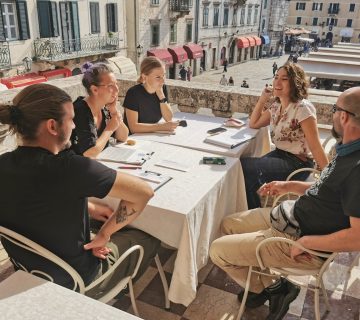Planning an interpretive trail might be an almost standardised process. However, planning an interpretive trail together with local people is something else. Whenever you have the chance to do so, take it!
Our task sounded fairly common. At the River Rhine, close to Düsseldorf, an old dam had been cut twice to recreate a wetland habitat. The idea was to allow the water to flood into the plain and to flow out again 2.5 km downstream. Each cut was spanned by a bridge and the length of the dam between the bridges should become a 2.5km long interpretive trail.
Visitor studies showed that 77% of the people walking that dam were repeated visitors, most of them residents. We initially assumed they might read any panel just once and that it would interfere with their enjoyment of future visits. Furthermore, opening the dam was controversial and panels could be seen as propaganda resulting in vandalism. However, funding had already been provided and so we had to think how to create a trail which would meet those challenges.
We suggested three workshops with residents (1) to train them in basic interpretive skills, (2) to ask them how they would like to see the area, and (3) to let them come up with their own suggestions. About 30 locals signed in and at the top of their wish list were – benches. The wish for interpretive media was rather limited. Asked for an overriding theme, they felt that ‘change’ played a significant role along that dam – in nature as well as for the people living nearby. So ‘Trail of Change’ became the title of our project.
Anyway, we now had to focus on benches. Examples from Scotland prooved how well messages work on backrests, and participants felt that using that approach would be a nice idea. Another idea was to use temporary installations. This resulted in simple text panels which could be easily replaced by our client and also temporary audio recordings where residents could share their own experiences (e.g. as children at that very site), or where immigrants living nearby could tell what ‘change’ means to them. Furthermore, we planned almost blank panels with markers attached where visitors could describe their own observations.
The workshops started in early 2014 and the trail opened in spring 2015. Our client was more than happy with all our wayside exhibits – except the panels to be filled by visitors which were soon covered with graffiti. However, considering that vandalism was an issue in that special area, we were pleased that almost all graffiti was limited to the panels meant to be filled – and that especially teenagers actually used that space in nature for exchange.
In autumn 2015, Cologne University did an evaluation showing a significant increase in visitor numbers, especially from abroad. Interpretive media received very positive feedback, serious vandalism was close to zero. 60% out of 600 interviewees said they learnt something new, and 90% said tax payers’ money was well invested. Although the term ‘interpretation’ is not common in Germany, another town immediately asked for an offer to create their own ‘Interpretationspfad’.
Our experience of planning that trail together with residents was absolutely positive. We felt that participation was key – and that it paid off for everyone.
|
The Trail of Change was part of ‘Auenblicke’, a project co-funded by the European Union. If you would like to know more about that project, go to www.auenblicke.de/website/index_e.html. |
Thorsten Ludwig is the owner of Bildungswerk interpretation, a consultancy founded in 1993 and dedicated to interpretive training and planning. Since 2015, he is Managing Director of Interpret Europe. You can get in touch with him at Th.Ludwig@interp.de.
To cite this article:
Ludwig, T. (2016) ‘Trail of change: natural heritage interpreted by locals’. In Interpret Europe Newsletter 2-2016, 10
Available online:
https://www.interpret-europe.net/fileadmin/Documents/publications/Newsletters/ie-newsletter_2016-2_summer.pdf




